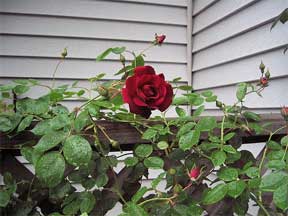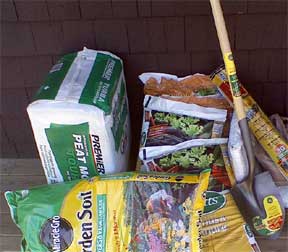How long do hybrid rose tea plants live? How many times have you been asked this question? It is one that takes much explaining to the beginner, sometimes even more explaining to one who has tried a few hybrid teas for one year and after unsatisfactory results has given them back to nature.
We always say longevity of a rose plant depends entirely upon the care it has received. We then usually proceed to explain watering, spraying methods, etc. But let’s start at the bottom of this thing. I do mean the bottom the soil.
Minimum Soil Standards
Experience and common sense, observing and indexing various types of soil and mixtures in rose beds have taught that for longevity, high quality and perfection of plant and bloom the plant must grow in soils having certain minimum standards. This soil should have respectable water holding capacity and still furnish adequate air to the roots. It must be capable of holding plant nutrients yet release them to the plant as needed and be of a durable structure. that will not collapse and become soggy when the fiber and humus has broken down.

Soil in a rose bed should be made up of such materials and in such sizes that it will stay open for downward transmission of water. A soil that soaks up water like a sponge and retains it will never allow much aeration and the roots therefore must try to survive in a soggy, stagnant, solid mass of materials.
Good Soil Provide Adequate Oxygen for Proper Respiration
Good mixture of soil must hold enough water by film strength to supply plants with water over a reasonable length of time and to permit the roots to be bathed continuously in a thin film of fresh water. Water which exists in the soil in thin films around the particles and around the roots is in constant contact with the fresh air flowing through the soil and therefore keeps the soil water fresh and allows it to carry adequate oxygen for proper respiration.
At the same time the by-products of respiration, carbon dioxide and other poisonous gases can be given off freely and carried from the soil in a natural upward circulation. The rose bed soil must maintain air spaces through its entire depth, from the top down to the very bottom root. Air spaces large enough to allow a rapid transfer of air downward and poisonous gases upward are a must.
Now this sounds like pure sand or some of the refractory materials, but they won’t do. Not unless you are prepared to pump a very weak solution of liquid fertilizers over it every few hours. The soil must contain enough clay and organic matter so that it can absorb on the surfaces the soil nutrients in available form.
It must hold these nutrients in such a way that they remain available to the plant root and can be obtained as the plant growth requires them. A mixture of just sand and gravel or either would have no nutrient holding capacity and would have to be watered and fertilized nearly every day. A fertilizer completely available at all times to the plant would have to be used in this case as there would be so few soil bacteria present in the sand and gravel no breakdown would occur.
Soil Must Have Durability and Structure
Since we build our rose and landscape beds to hold and grow the same plants over a period of several years this soil must have durability, structure which will permit the exchange of water and soil gases, nutrient-holding capacity as well as sufficient humus for correct growth of soil bacteria.
If an organic material that decomposes rapidly, such as old fashioned cow manure, is used this soil structure will break down rapidly and the soil particles will flow together causing a slowing down of the air and water transfers. Some resistant materials should be used with cow manure if cow manure or other fast decaying materials are used, to allow good growing conditions to exist even after the decayed matter has collapsed.

This may be done by mixing sand, fibrous peat moss, fine cinders, expanded shale or mica, finely ground limestone if the soil should be on the acid side. Use whatever is available in your community that will not decay rapidly and will not upset the pH of the soil. Fine cinders after a few rains have leached them, sand, vermiculite and expanded shale are neutral in their reaction.
German or Danish peat contains much coarse fiber and breaks down slowly but is more acid than the American peats. In soils testing higher than 6.6 this acid bearing peat would not be apt to cause any tie-up of materials as it is unlikely to drop the soil acid too low. In soils already on the acid side (below 6.5) some limestone would have to be added. Remember, however, the rose plant is very versatile and given the proper soil media in which to grow it will perform well with a little help from you.
I believe it is always well to use plenty of coarse peat as well as vermiculite or cinders or sand in heavy clay soils. If only sand or other sharp materials are used here the clay usually sticks fast to the edges of these materials and pretty soon we have that same solid mass again.
Seek Advice on Local Soils
Eight bushels of peat and the same amount of resistant materials to each 100 square feet of bed to be made is certainly not too much in heavy, clay soils. The amount of the materials in the soil mixtures should be determined either by experimentation or on the advice of people who have had considerable experience growing roses in the same type of soil.
A dormant, bare root, budded rose plant does not need much fertilizer the first two months after being planted provided, of course, the soil in the beds is of average fertility. Some materials, bone meal or phosphates of any kind do not travel downward through the soil at a rapid pace and should be mixed all through the soil when preparing the bed but the nitrogenous fertilizers are not very much in demand until many new roots and foliage have been made.
So let’s not mix much nitrogenous material into the soil before the planting. After planting the soil is usually pulled up in mounds around the new plant to prevent drying out from the wind and to protect from late frosts. However, when the danger of severe freezes is over and three or four inches of new growth have been attained the mound should be removed, either leveling it out on the bed or taking it completely away so the sun can reach the bud union of the plant.
This promotes new bottom or cane growth. The soil surface should then be scratched about an inch deep. a light application of fertilizer containing more nitrogen than other elements (about three pounds per 25 plants) put on the scratched surface and about one inch of good, loose mulch put on top of this.
It is well if you do not mulch over the bud union at this time, it likes the light. The mulch helps to keep the soil from packing, prevents weeds from growing and certainly conserves moisture. After the first crop of bloom is over and new shoots come from the stem from which the old blooms were removed you may again fertilize using the same material and the same amount as previously.
The longevity of your roses depends on you.
Contributed by C.P. Dawson
